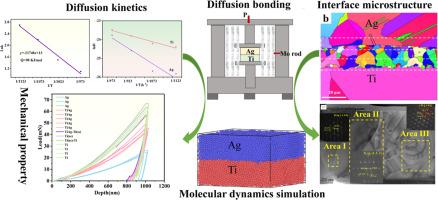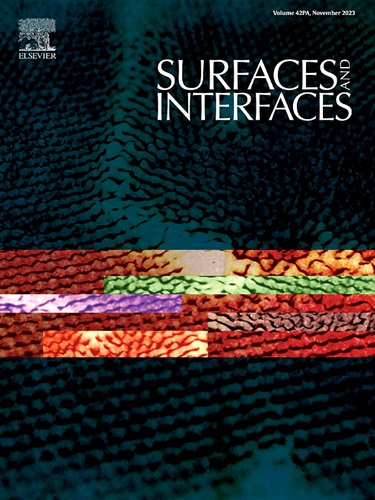银/钛扩散键的实验研究与分子动力学模拟
IF 5.7
2区 材料科学
Q2 CHEMISTRY, PHYSICAL
引用次数: 0
摘要
通过实验和分子动力学模拟研究了 Ag/Ti 扩散耦合的扩散动力学和机制。研究了温度(700 °C 至 850 °C)和保温时间(15 分钟至 60 分钟)等加工参数对 Ag/Ti 接头微观结构和相形成的影响。此外,还评估了接头的机械性能。扩散界面上存在包括 AgTi、Ti2Ag 和 Ti(ss,Ag)固溶体在内的 IMC。TiAg 相生长的活化能为 98 kJ/mol。分子动力学模拟显示,与 Ti(2.5×10-8 m2/s)相比,Ag 的扩散系数更高(5.0×10-5 m2/s)。同时,TiAg/Ti 界面的晶粒明显小于 TiAg/Ag 侧的晶粒。这些结果表明,Ag 的扩散通量高于 Ti 的扩散通量,在界面上形成了 TiAg 相优先。晶界扩散是一种扩散控制机制。界面上的 Ti(ss,Ag)固溶体表现出最高的纳米硬度和模量,分别为 4.2 ± 0.1 GPa 和 139.6 ± 0.6 GPa。在 750 °C 下钎焊 30 分钟的接头显示出 98 兆帕的最大剪切强度,断裂主要发生在 Ag 相和 TiAg 相之间的界面上。这项研究深入揭示了银/钛扩散偶的扩散行为、相形成动力学和力学性能,为各种工程应用中先进材料的开发提供了启示。本文章由计算机程序翻译,如有差异,请以英文原文为准。

Experimental study and molecular dynamics simulation of Ag/Ti diffusion bonding
The diffusion kinetics and mechanisms of Ag/Ti diffusion couple were investigated through experiments and molecular dynamics simulations. The influence of processing parameters, such as temperature (700 °C to 850 °C) and holding time (15 min to 60 min), on microstructure and phase formation at the Ag/Ti joint was studied. In addition, the mechanical properties of the joints were evaluated. IMCs including AgTi, Ti2Ag, and the Ti(ss, Ag) solid solution exist at the diffusion interface. The activation energy for the growth of the TiAg phase is 98 kJ/mol. Molecular dynamics simulations show that Ag has a higher diffusion coefficient (5.0×10-5 m2/s) compared to Ti (2.5×10-8 m2/s). Meanwhile, the grains at the TiAg/Ti interface are significantly smaller than those at the TiAg/Ag side. These results indicate that the diffusion flux of Ag is higher than that of Ti, and the TiAg phase priority is formed at the interface. The grain boundary diffusion is a diffusion control mechanism. The Ti(ss, Ag) solid solution at the interface exhibits the highest nano-hardness and modulus, with values of 4.2 ± 0.1 GPa and 139.6 ± 0.6 GPa, respectively. The joint brazed at 750 °C for 30 min shows a maximum shear strength of 98 MPa, with fractures primarily occurring at the interface between the Ag and TiAg phases. This study provides insights into the diffusion behavior, phase formation dynamics, and mechanical properties of Ag/Ti diffusion couples, offering implications for the development of advanced materials in various engineering applications.
求助全文
通过发布文献求助,成功后即可免费获取论文全文。
去求助
来源期刊

Surfaces and Interfaces
Chemistry-General Chemistry
CiteScore
8.50
自引率
6.50%
发文量
753
审稿时长
35 days
期刊介绍:
The aim of the journal is to provide a respectful outlet for ''sound science'' papers in all research areas on surfaces and interfaces. We define sound science papers as papers that describe new and well-executed research, but that do not necessarily provide brand new insights or are merely a description of research results.
Surfaces and Interfaces publishes research papers in all fields of surface science which may not always find the right home on first submission to our Elsevier sister journals (Applied Surface, Surface and Coatings Technology, Thin Solid Films)
 求助内容:
求助内容: 应助结果提醒方式:
应助结果提醒方式:


